C.2.城市景观城市人口密度(Urbanpopulationdensity)
城市生态学

1.2.2 巴黎的改建
自17世纪以来,巴黎一直按着古典美学原则进 行建设,把城市的道路和广场构成美丽的图案, 推崇圆广场放射线型的路,讲究轴线、构图。
巴黎的改建使城市的交通有了明显的改善,适 应了当时马车快速行驶的要求,以及后来出现 的机动车交通。1852巴黎改建, 在改建中,在重 点地段加强了街道绿化,建了许多街心花园。
1.1.3 研究意义
城市是人类文明的标志,是一个时代的经 济、政治、社会、科学、文化、生态环境 发展和变化的焦点和结晶体。
城市的优势在于工业、人口、市场、文化 和科学技术的集中,这有利于生产的专业 化、协作化和新型高度精尖技术密集工业 的发展,有利人员流动、物质流通。
但是城市的缺点也恰恰在于人口和工业的过量集中和密 度过大,在城市化地区,进行着大量的资源利用、物质 变换、能量流动、产品消费等活动,从而使自然资源大 量耗用和各种生产、生活废料大量产出,引起了一系列 城市问题。如人口密集、住房困难、土地资源紧张、工 业资源短缺、水源短缺、交通拥挤、环境污染、疾病流 行 、 犯 罪 增 多 、 就 业 困 难 等 等 。 (3R, reduce, reuse, recycle).
城市景观生态学 (Urban landscape ecology) 从景观尺度研究城市不同生态系统之间代谢过 程的物流、能流和信息流的转化、利用效率等 问题。
山农成人教育 城市地理学期末考试复习题及参考答案

1、填空题
1、城市地理学最重要的任务是揭示和预测世界各国,各地区城市现象发展变化的规律性。
2、在我国按人口数量划分城市规模中,大城市城市常驻人口介于100——500万人之间
3、两个城市间的相互作用与这两个城市的人口规模成正比,与它们之间的距离成反比。
4、景观、人口密度、基础设施、经济结构等(意思相近即可得分)
1、正确书写区位商公式,并利用区位商公式计算2010年海南入境过夜旅游中外国游客的区位商。(10分)
2、对得出区位商数值进行简要分析。(5分)
五、问答题
1、简述克里斯塔勒中心地理论的需求门槛与最大销售距离之间的关系。(10分)
2、城市面临的主要“城市问题”?(25分)
3、为什么说中心地理论标志着现代城市地理学的形成?
《城市地理学》复习题
一、填空题
1、城市地理学最重要的任务是。
2、在我国按人口数量划分城市规模中,大城市城市常驻人口介于——万人之间。
3、两个城市间的相互作用与这两个城市的人口规模成,与它们之间的距离成。
4、城乡差异可以体现在、、、
等方面。
5、空间扩散由三基本类型:、、。
6、空间相互作用产生的条件:、、。
5、空间扩散由三种基本类型:传染扩散、等级扩散和重新区位扩散。
6、空间相互作用产生的条件:互补性、中介性、可运输性。
7、50年代空间学派兴起以后,城市地理学其研究对象分:宏观城市空间、微观城市空间。
8、目前确定城市化指标及测度方法主要有两种:主要指标法和复合指标法。
9、列举三个人口超过1000万的国外超特大型城市纽约 、 东京 、 墨西哥城。
10、周一星认为中国东南沿海的长江三角洲和珠江三角洲已形成了两个都市连绵区,并认为辽中南、京津唐已有都市连绵区的雏形。
城市规划名词解释

城市规划名词解释一、城市和城市化1、居民点settlement人类按照生产和生活需要而形成的集聚定点地点。
按性质和人口规模,居民点分为城市和乡村两大类。
2、城市(城镇)city以非农业和非农业人口聚集为主要特征的居民点。
包括按国家行政建制设立的市和镇。
3、市municipality ; city经国家批准设市建制的行政地域。
4、镇town经国家批准设镇建制的行政地域。
5、市域administrative region of a city城市行政管辖的全部地域。
6、城市化(城镇化、都市化)urbanization人类生产和生活方式由乡村型向城市型转化的历史过程,表现为乡村人口向城市人口转化以及城市不断发展和完善的过程。
人类进入工业社会时代,社会经济发展中农业活动的比重逐渐下降和非农业活动的比重逐步上升的过程。
与这种经济结构的变化相适应,出现了乡村人口的比重逐渐下降,城市人口的比重稳步上升,居民点的物质面貌和人们的生活方式逐渐向城市型转化或强化的过程。
随着时间推移,某一社会的逐步集中于高人口密度社会的过程,也可以说是人口由农村迁移到城市的过程。
7、城市化水平urbanization level衡量城市化发展程度的数量指标,一般用一定地域内城市人口占总人口的比例来表示。
8、城市群agglomeration一定地域内城市分布较为密集的地区。
9、城镇体系urban system一定区域范围内在经济、社会和空间发展上具有有机联系的城市、城镇群体。
10、卫星城(卫星城镇)satellite town在大城市市区外围兴建的、与市区既有一定距离又相互间密切联系的城市。
二、城市规划概述1、城镇体系规划urban system planning综合评价城镇发展条件,制定区域城镇发展战略,预测区域人口增长和城市化水平,并以区域生产力合理布局和城镇职能分工为依据,确定不同人口规模等级和职能分工的城镇的分布和发展规划,协调城镇发展与产业配置的时空关系,统筹安排区域基础设施和社会设施,引导和控制区域城镇的合理发展和布局,指导城市总体规划的编制。
城市生态学(4.2.2)--城市人口的基本特征

第二节 城市人口的基本特征人口结构是城市人口的基本特征,城市人口结构(urban population structure),又称城市人口构成。
将城市人口按其各种属性表现出的差别构成分类的比例,可分为两类:(1)城市人口自然结构,如性别结构、年龄结构等;(2)城市人口社会结构,如阶级结构、民族结构、家庭结构、文化结构、宗教结构、语言结构、职业结构、经济收入结构等。
城市人口的数量、年龄、性比、密度、分布和行业特征等等都是城市人口要素。
这些要素从不同角度反映了城市人口结构的状况。
一.城市人口数量城市人口数量或人口大小是指城市区域内人口的总个体数,含固定人口总数和流动人口总数。
城市人口的数量是不断地变化的,造成其变化的因素是多方面的。
但从个体数量上的变动来看,则表现为由人口的出生率、死亡率、迁(流)入率和迁(流)出率四个基本参数所决定。
这样,种群在某个特定时间内的数量变化能用下式表示:N t+1=N t+B-D+I-E式中,N t是时间t时的人口数量;N t+1是一个时期后人口数量;B、D、I、E分别是在时间t和t+1期间出生、死亡、迁(流)入和迁(流)出的个体数,城市人口基数(t时间的城市人口数)和人口的出生率、死亡率、迁(流)入率和迁(流)出率一起影响着城市人口的发展规模。
如果不考虑迁(流)入和迁(流)出的人口个体数的变化情况,城市人口数量亦可简化为:N t+1=N t+B-D这样在单位时间内,出生数和死亡数之差等于人口的增长量。
因此,城市人口数量的变化取决于出生率和死亡率的对比关系。
出生数多于死亡数时,表现为正增长,出生数少于死亡数时,表现为负增长,出生数等于死亡数时,人口数量相对稳定。
另外,城市人口的寿命、出生率、死亡率、转化率和迁移率等都深受城市的自然环境和社会环境因素的影响,因此城市环境与人口数量仍有着密切的关系。
二.城市人口的年龄结构种群的年龄结构(age structure)反映的是种群不同年龄的个体数量的分布情况。
用人口密度界定城市的方法
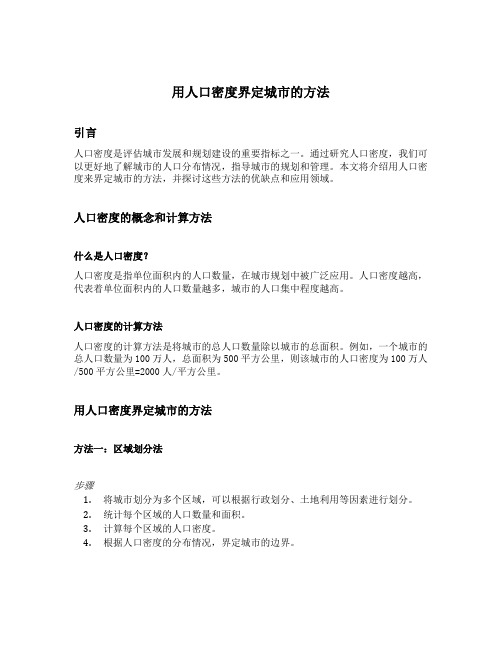
用人口密度界定城市的方法引言人口密度是评估城市发展和规划建设的重要指标之一。
通过研究人口密度,我们可以更好地了解城市的人口分布情况,指导城市的规划和管理。
本文将介绍用人口密度来界定城市的方法,并探讨这些方法的优缺点和应用领域。
人口密度的概念和计算方法什么是人口密度?人口密度是指单位面积内的人口数量,在城市规划中被广泛应用。
人口密度越高,代表着单位面积内的人口数量越多,城市的人口集中程度越高。
人口密度的计算方法人口密度的计算方法是将城市的总人口数量除以城市的总面积。
例如,一个城市的总人口数量为100万人,总面积为500平方公里,则该城市的人口密度为100万人/500平方公里=2000人/平方公里。
用人口密度界定城市的方法方法一:区域划分法步骤1.将城市划分为多个区域,可以根据行政划分、土地利用等因素进行划分。
2.统计每个区域的人口数量和面积。
3.计算每个区域的人口密度。
4.根据人口密度的分布情况,界定城市的边界。
优点•能够更加准确地反映城市内不同区域的人口密度差异。
•既可以考虑到整体的人口分布情况,又能够考虑到局部的特殊情况。
缺点•需要收集大量的数据,并进行精确的统计和计算。
•区域划分可能存在主观性和争议性。
方法二:等高线法步骤1.统计城市内不同区域的海拔高度。
2.根据海拔高度绘制等高线图。
3.根据等高线的分布情况,界定城市的边界。
优点•能够考虑到地理环境对人口聚集的影响。
•比较客观,不会受到主观因素的干扰。
缺点•需要大量的地理数据和专业的绘图技术。
•不适用于地理环境较为均匀的城市。
人口密度界定城市的应用领域城市规划和土地利用•通过研究城市的人口密度分布情况,可以指导城市规划和土地利用,合理安排不同功能区域的布局,提高土地利用效率。
•根据人口密度可以判断哪些地区需要增加公共设施和基础设施的建设,满足人民的生活需求。
社会经济发展•人口密度是评估城市发展水平的重要指标之一。
研究人口密度可以帮助政府和企业了解不同城市的发展潜力和市场需求,制定相应的发展策略。
城市规划学公式速查手册人口密度与城市发展的计算公式
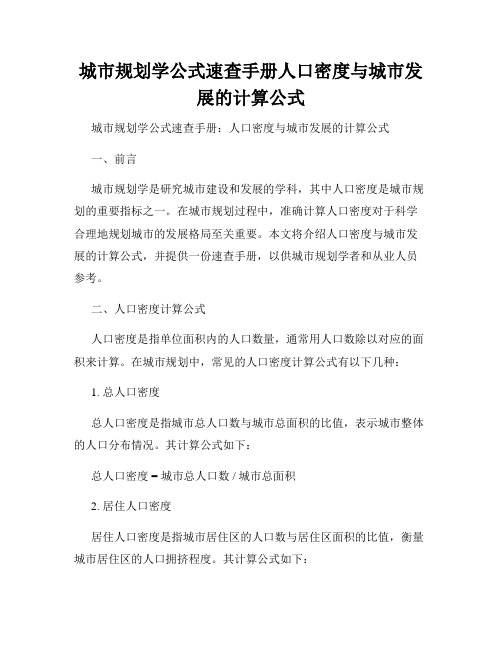
城市规划学公式速查手册人口密度与城市发展的计算公式城市规划学公式速查手册:人口密度与城市发展的计算公式一、前言城市规划学是研究城市建设和发展的学科,其中人口密度是城市规划的重要指标之一。
在城市规划过程中,准确计算人口密度对于科学合理地规划城市的发展格局至关重要。
本文将介绍人口密度与城市发展的计算公式,并提供一份速查手册,以供城市规划学者和从业人员参考。
二、人口密度计算公式人口密度是指单位面积内的人口数量,通常用人口数除以对应的面积来计算。
在城市规划中,常见的人口密度计算公式有以下几种:1. 总人口密度总人口密度是指城市总人口数与城市总面积的比值,表示城市整体的人口分布情况。
其计算公式如下:总人口密度 = 城市总人口数 / 城市总面积2. 居住人口密度居住人口密度是指城市居住区的人口数与居住区面积的比值,衡量城市居住区的人口拥挤程度。
其计算公式如下:居住人口密度 = 居住区人口数 / 居住区面积3. 就业人口密度就业人口密度是指城市就业区的人口数与就业区面积的比值,反映了城市经济活动的集中程度。
其计算公式如下:就业人口密度 = 就业区人口数 / 就业区面积4. 商业人口密度商业人口密度是指城市商业区的人口数与商业区面积的比值,考察了城市商业活动的集聚情况。
其计算公式如下:商业人口密度 = 商业区人口数 / 商业区面积5. 教育人口密度教育人口密度是指城市教育区的人口数与教育区面积的比值,反映了城市教育资源分布情况。
其计算公式如下:教育人口密度 = 教育区人口数 / 教育区面积注意:以上公式中的人口数和面积都应采用相同的单位进行计算,以保证结果的准确性。
三、速查手册为方便城市规划学者和从业人员使用,以下是人口密度计算公式的速查手册:1. 总人口密度公式:总人口密度 = 城市总人口数 / 城市总面积2. 居住人口密度公式:居住人口密度 = 居住区人口数 / 居住区面积3. 就业人口密度公式:就业人口密度 = 就业区人口数 / 就业区面积4. 商业人口密度公式:商业人口密度 = 商业区人口数 / 商业区面积5. 教育人口密度公式:教育人口密度 = 教育区人口数 / 教育区面积使用时,请根据需要选择对应的计算公式,并填入相应的数据进行计算。
(完整版)城市规划相关名词解释

(完整版)城市规划相关名词解释1吴良镛先生提出的“融贯的综合研究方法”《人居环境科学导论》一书中,人居环境科学是这样释义的:“人居环境科学就是围绕地区的开发、城乡发展以及诸多问题进行研的学科群,它是联贯一切与人类居住环境的形成与发展有关的,包括自然科学、技术科学和人文科学的新的学科体系,其涉及领域广泛,是多学科的结合。
”一法得道变法万千——谈“人居环境科学”的整体性和复杂性吴良镛先生的《人居环境科学导论》开宗明义,首先强调把人类聚居作为一个整体,而非如传统建筑学那样,只涉及人类聚居的某一部分或是某一个侧面,在论述了“人居环境科学”的缘起后,设计出一个基本研究框架和学科体系,并就其中部分与整体的区别与联系作了详细论述,展开了在以五大原则(生态观、经济观、科技观、社会观、文化观)指导下的五大系统(自然、人、社会、居住、支撑网络)和五大层次(建筑、社区、城市、区域、全球)的系统性研究。
提出运用系统思想和复杂性科学方法为指导,进行适合中国国情的理论建构、设计实践与教育改革,目的在于了解、掌握人类聚居发生、发展的客观规律,从而更好地建设符合人类理想的可持续发展的人类聚居环境。
范式转变,人居环境科学的发展与趋势1、从简单还原性为主的类型研究到进一步探索复杂性,关注系统性以往在线性思维的模式下,追求片面简化,孤立地强调问题的因果还原性,只注重单一领域内人居环境目的与需求的分析,忽视了整个设计目标系统中相关因素的时空与人的变量,往往造成决策失误。
人居环境科学研究发展了贝塔朗菲的系统论思想:“我们将被迫在知识的一切领域中运用整体或者系统来处理复杂性问题,这将是科学思维的一个根本改造。
”①同样,这也是探索人居环境科学的唯一出路。
2、从侧重物质形式,到关注生命、智能和生态环境在人居环境几千年的探索历程中,我们曾走过许多弯路,然而如今我们发现:人居环境研究的核心是人②,探索对象的全部意义在于其与人的关系,由此设计发明了许多一定条件下满足人类聚居需求的方法,进而凝结成一个个具体的物质形式;各种时代的风格样式,只是设计的外在表现形式,随着时空的变化,人居环境的需求也在不断,其物质形式将不可穷尽,我们要抓住的根本是:关注生命,进而将视野扩展至包括物质领域到非物质领域的更多层面,用现代化的科技创造与自然和谐统一的人类适宜的聚居环境。
城市人口密度

农业密度
农业密度
农业密度是一项表达人口与农业,特别是食物产量的关系比较密切的指标。它是表示一地区内总的农田数与 农民数的比例。这个数字充分表现出一个地区的农业生产的效率。在经济发达的国家,由于多采用机械,使用劳 动力比较少,农业密度就低。农业密度低说明每个从事农业的人口能供养较多的非农业人口,说明可有更多的劳 力从事其他产业。
人口密度
人口密度
必须指出,人口密度这一概念虽然应用得比较广泛,它把单位面积的人口数表现得相当清楚。但是,这一概 念也有不足之处。例如,它考虑的只是陆地土地的面积,并未考虑土地的质量与土地生产情况。以我国的情况来 说,江苏人口的平均密度约为600人/平方千米,而西藏的平均人口密度为1人/平方千米。从数字上看,会认为西 藏人口稀少,江苏人口过密,同时,也会想到西藏土地在供养人口方面还有很大的潜力。其实,情况往往并非如 此。西藏地区是海拔平均4000米的高原和山地,耕地只限狭窄的南部河谷地区等,实际耕地面积很有限;高原上 的草场,由于干寒,产草量很低,单位面积的载畜量也很有限。相反,江苏位于长江入海处,有大片的长江三角 洲平原,开辟成的水农田的生产力很高,所以有效的耕地面积远远超过西藏。因此,改用其他表示人口密度的方 法,其中有:生理密度(physiological density)与农业密度(agric-ultural density)。而把前面以面积 计的人口密度,称为人口的数学密度(arithmatic density)。
等级划分
等级划分
我们可以从人口密度的分布来看世界人口分布的情况。一般把人口的密度分为几个等级: 第一级人口密集区 >100人/平方千米 第二级人口中等区 25~100人/平方千米 第三级人口稀少区 1~25人/平方千米 第四级人口极稀区 <1人/平方千米
环境卫生名词解释和问答题,
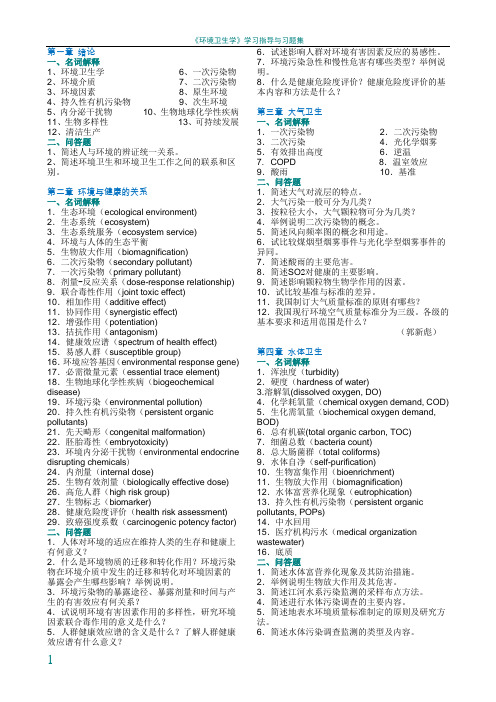
第一章绪论一、名词解释1、环境卫生学6、一次污染物2、环境介质7、二次污染物3、环境因素8、原生环境4、持久性有机污染物9、次生环境5、内分泌干扰物10、生物地球化学性疾病11、生物多样性13、可持续发展12、清洁生产二、问答题1、简述人与环境的辨证统一关系。
2、简述环境卫生和环境卫生工作之间的联系和区别。
第二章环境与健康的关系一、名词解释1.生态环境(ecological environment)2.生态系统(ecosystem)3.生态系统服务(ecosystem service)4.环境与人体的生态平衡5.生物放大作用(biomagnification)6.二次污染物(secondary pollutant)7.一次污染物(primary pollutant)8.剂量-反应关系(dose-response relationship) 9.联合毒性作用(joint toxic effect)10.相加作用(additive effect)11.协同作用(synergistic effect)12.增强作用(potentiation)13.拮抗作用(antagonism)14.健康效应谱(spectrum of health effect) 15.易感人群(susceptible group)16.环境应答基因(environmental response gene) 17.必需微量元素(essential trace element) 18.生物地球化学性疾病(biogeochemical disease)19.环境污染(environmental pollution)20.持久性有机污染物(persistent organic pollutants)21.先天畸形(congenital malformation)22.胚胎毒性(embryotoxicity)23.环境内分泌干扰物(environmental endocrine disrupting chemicals)24.内剂量(internal dose)25.生物有效剂量(biologically effective dose) 26.高危人群(high risk group)27.生物标志(biomarker)28.健康危险度评价(health risk assessment) 29.致癌强度系数(carcinogenic potency factor) 二、问答题1.人体对环境的适应在维持人类的生存和健康上有何意义?2.什么是环境物质的迁移和转化作用?环境污染物在环境介质中发生的迁移和转化对环境因素的暴露会产生哪些影响?举例说明。
建筑专业英语词汇整理大全模板

建筑专业英语词汇整理大全常用景观英文1.主入口大门/岗亭(车行 & 人行) MAIN ENTRANCE GATE/GUARDHOUSE (FOR VEHICLE& PEDESTRIAN )2.次入口/岗亭(车行 & 人行 ) 2ND ENTRANCE GATE/GUARDHOUSE (FOR VEHICLE& PEDESTRIAN )3.商业中心入口 ENTRANCE TO SHOPPING CTR.4.水景 WATER FEATURE5.小型露天剧场 MINI AMPHI-THEATRE6.迎宾景观-1 WELCOMING FEATURE-17.观景木台 TIMBER DECK (VIEWING)8.竹园 BAMBOO GARDEN9.漫步广场 WALKWAY PLAZA10.露天咖啡廊 OUT DOOR CAFE11.巨大迎宾水景-2 GRAND WELCOMING FEATURE-212.木桥 TIMBER BRIDGE13.石景、水瀑、洞穴、观景台 ROCK'SCAPE WATERFALL'S GROTTO/VIEWING TERRACE14.吊桥 HANGING BRIDGE15.休憩台地(低处) LOUNGING TERRACE (LOWER )16.休憩台地(高处) LOUNGING TERRACE (UPPER )17.特色踏步 FEATURE STEPPING STONE18.野趣小溪 RIVER WILD19.儿童乐园 CHILDREN'S PLAYGROUND20.旱冰道 SLIDE21.羽毛球场 BADMINTON COURT22.旱景 DRY LANDSCAPE23.日艺园 JAPANESE GARDEN24.旱喷泉 DRY FOUNTAIN25.观景台 VIEWING DECK26.游泳池 SWIMMING POOL27.极可意 JACUZZI28.嬉水池 WADING POOL29.儿童泳池 CHILDREN'S POOL30.蜿蜒水墙 WINDING WALL31.石景雕塑 ROCK SCULPTURE32.中心广场 CENTRAL PLAZA33.健身广场 EXERCISE PLAZA34.桥 BRIDGE35.交流广场 MEDITATING PLAZA36.趣味树阵 TREE BATTLE FORMATION37.停车场 PARING AREA38.特色花架 TRELLIS39.雕塑小道 SCULPTURE TRAIL40.(高尔夫)轻击区 PUTTING GREEN41.高尔夫球会所 GOLF CLUBHOUSE42.每栋建筑入口 ENTRANCE PAVING TO UNIT43.篮球场 BASKETBALL COURT44.网球场 TENNIS COURT45.阶梯坐台/种植槽 TERRACING SEATWALL/PLANTER46.广场 MAIN PLAZA47.森林、瀑布 FOREST GARDEN WATERFALL48.石景园 ROCKERY GARDEN49.旱溪 DRY STREAM50.凉亭 PAVILION51.户外淋浴 OUTDOOR SHOWER52.拉膜构造 TENSILE STRUCTURE53.台阶 STAIR54.高尔夫球车停车场 PARKING ( GOLF CAR )55.健身站 EXERCISE STATION56.晨跑小路 JOGGING FOOTPATH57.车道/人行道 DRIVEWAY /SIDEWALK58.人行漫步道 PROMENADE59.瀑布及跳舞喷泉(入口广场) WATER FALL AND DANCINGFOUNTAIN ( ENTRY PLAZA )60.特色入口 ENTRY FEATURE 61.石景广场 ROCKERY PLAZA常用造价英语词汇常用造价英语词汇估算/费用估算:estimate/cost estimate;估算类型:types of estimate;详细估算:是偏差幅度最小估算,defined estimate;设备估算:equipment estimate;分析估算:analysis estimate;报价估算:proposal estimate;控制估算:control estimate;初期控制估算:interim control estimate/initial controlestimate批准控制估算:initial approved cost核定估算:check estimate首次核定估算:first check estimate二次核定估算:production check estimate人工时估算:man hour estimate材料费用/直接材料费用:material cost/direct materialcost设备费用/设备购置费用:equipment cost/purchased cost ofequipment散装材料费用/散装材料购置费用:bulk materialcost/purchased cost of bulk material施工费用:construction cost施工人工费用:labor cost/construction force cost设备安装人工费用:labor cost associated with equipment 散装材料施工安装人工费用:labor cost associated with bulkmaterials人工时估算定额:standard manhours施工人工时估算定额:standard labor manhours标准工时定额:standard hours劳动生产率:labor productivity/productivityfactor/productivity ratio修正人工时估算值:adjusted manhours人工时单价:manhours rate施工监视费用:cost of construction supervision施工间接费用:cost of contruction indirects分包合同费用/现场施工分包合同费用:subcontractcost/field subcontract cost公司本部费用:home office cost公司管理费用:overhead非工资费用:non payroll开车效劳费用:cost of start-up services其他费用:other cost利润/预期利润:profit/expected profit效劳酬金:service gains风险:risk风险分析:risk analysis风险备忘录:risk memorandum未可预见费:contingency根本未可预见费:average contingency 最大风险未可预见费:maximum risk contingency用户变更/合同变更:cilent change/contract change 认可用户变更:approved client change待定用户变更:pending client change工程变更:project change内部变更:internalchange批准变更:authoried change强制性变更:mandatory change选择性变更:optional change内部费用转换:internal transfer认可预计费用:anticipated approved cost涨价值:escalation工程费用汇总报告:project cost summary report工程实施费用状态报告:project operation cost statusreport总价合同:lump sum contract偿付合同:reimbursible contract预算:budget规划专业英语规划词典环境、根底设施、交通运输环境设计( Environmental design ) 以物质环境质量为根本点,以优良环境是人根本权利与需要为前提土地利用规划。
城市规划行业中人口密度数据分析报告

城市规划行业中人口密度数据分析报告概述本报告旨在通过对城市规划行业中人口密度数据的分析,揭示人口密度的重要性以及如何利用这些数据来指导城市规划决策。
我们将从不同角度出发,包括人口密度的定义、计算方法、影响因素和应用案例等方面进行深入探讨。
1. 人口密度的定义与计算方法人口密度是指单位面积内的人口数量,通常用人口数量除以土地面积得出。
计算人口密度时,需要综合考虑城市的总人口规模和面积,以及在特定时间段内的人口分布情况。
常用的计算方法有总体人口密度和区域人口密度两种。
2. 人口密度的影响因素人口密度的高低对城市规划有着重要的影响。
人口密度的主要影响因素包括城市规模、土地利用方式、交通网络和公共设施等。
较高的人口密度通常意味着更高的资源利用效率和经济活力,但也可能导致交通拥堵、环境压力和社会问题等挑战。
3. 人口密度数据的应用案例3.1 城市规划与土地利用人口密度数据是制定城市规划和土地利用政策的重要参考依据。
通过分析人口密度分布,可以确定合理的发展区域和控制重点发展区域,从而实现合理的土地利用和资源配置。
3.2 交通规划与道路网络人口密度数据对交通规划有着重要的指导作用。
基于人口密度数据,可以预测城市交通需求,合理规划道路网络和公共交通线路,优化交通出行结构,提高交通效率。
3.3 公共设施布局与社会服务人口密度数据对公共设施的布局和社会服务的提供也起到了关键的影响作用。
通过分析人口密度分布,可以确定公共设施建设的重点区域,满足居民的基本需求,提高城市的居住质量。
4. 结论与展望人口密度数据在城市规划行业中的重要性不可忽视。
合理分析和利用人口密度数据有助于优化城市发展布局,提高城市建设的质量和效益。
未来,随着智能技术的不断进步,人口密度数据的分析方法和应用将得到进一步的改进和拓展。
参考文献:[1] 张三, 李四. 城市规划与人口密度数据分析. 城市规划学刊, 2018, 10(2).[2] Smith, J., & Johnson, A. (2019). Urban Planning and Population Density: A Case Study in City XYZ. Journal of Urban Planning, 25(1), 45-62.。
城市人口的基本特征

三、 城市人口性比 人口总数某个龄级的个体中男性对女性的比例. 城市人口性别构成(sex structure of urban population)是城市人口自然结构的基本要素之一。 四、 城市人口密度 (一)城市人口密度(urban population density) 城市人口密度:指城市区域内单位面积上居住 的人口数。
城市人口结构(structure):①城市人口自然结构,如性 别、年龄等;②城市人口社会结构,如民族、家庭、文 化、区域内人口的总个体数,含固定人口总数和 流动人口总数。
城市人口的数量是不断的变化的,由人口的出生 率、死亡率、迁入率、迁出率四个参数决定。
➢Nt+1=Nt+B-D+I-E ➢Nt是时间t的人口数量; Nt+1是1个时期后人口数量; B.D.I.E分别是在时间t和t+1期间出生(born)、死亡 (decease)、迁入(immigrate)、迁出(emigrate)的个体数。
二、 城市人口的年龄结构(age structure)
反映不同年龄的个体数量的分布情况。 一般将人口划分成:托幼年龄、中小学年龄、 劳动年龄和老龄;或:幼龄、中龄和老龄。 人口年龄结构模型:增长型、稳定型和衰退型
第二节 城市人口(urban population) 居住在城市规划区域建成区内的一切人口,一切从事 城市的社会,经济和文化等活动,享受着城市公共设施。 在中国特定为居住在城市范围内并持有城市户口的人口。
城市的一切设施和物质供应,活动场所必须考虑容纳 这些人口,并为他们提供各种各样的服务。可用城市人 群来表示城市人口。
(二)城市人口过密化
城市人口密度过大,超过合理密度的状态,是人 口在城市过度集中的表现. 东京、纽约等是公认的过密城市上海城市化地域 面积为东京的40%。 发达国家大城市地域的城市人口主要分布在半径 50km的实际城市化范围内,而中国则为10km。
城市生态学名词解释
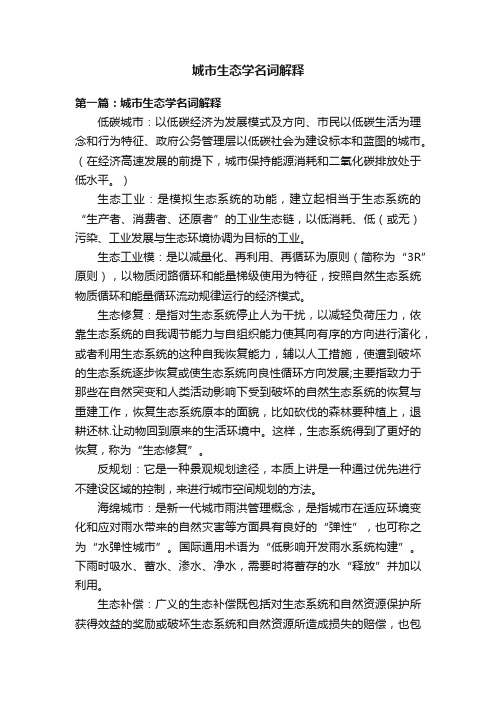
城市生态学名词解释第一篇:城市生态学名词解释低碳城市:以低碳经济为发展模式及方向、市民以低碳生活为理念和行为特征、政府公务管理层以低碳社会为建设标本和蓝图的城市。
(在经济高速发展的前提下,城市保持能源消耗和二氧化碳排放处于低水平。
)生态工业:是模拟生态系统的功能,建立起相当于生态系统的“生产者、消费者、还原者”的工业生态链,以低消耗、低(或无)污染、工业发展与生态环境协调为目标的工业。
生态工业模:是以减量化、再利用、再循环为原则(简称为“3R”原则),以物质闭路循环和能量梯级使用为特征,按照自然生态系统物质循环和能量循环流动规律运行的经济模式。
生态修复:是指对生态系统停止人为干扰,以减轻负荷压力,依靠生态系统的自我调节能力与自组织能力使其向有序的方向进行演化,或者利用生态系统的这种自我恢复能力,辅以人工措施,使遭到破坏的生态系统逐步恢复或使生态系统向良性循环方向发展;主要指致力于那些在自然突变和人类活动影响下受到破坏的自然生态系统的恢复与重建工作,恢复生态系统原本的面貌,比如砍伐的森林要种植上,退耕还林.让动物回到原来的生活环境中。
这样,生态系统得到了更好的恢复,称为“生态修复”。
反规划:它是一种景观规划途径,本质上讲是一种通过优先进行不建设区域的控制,来进行城市空间规划的方法。
海绵城市:是新一代城市雨洪管理概念,是指城市在适应环境变化和应对雨水带来的自然灾害等方面具有良好的“弹性”,也可称之为“水弹性城市”。
国际通用术语为“低影响开发雨水系统构建”。
下雨时吸水、蓄水、渗水、净水,需要时将蓄存的水“释放”并加以利用。
生态补偿:广义的生态补偿既包括对生态系统和自然资源保护所获得效益的奖励或破坏生态系统和自然资源所造成损失的赔偿,也包括对造成环境污染者的收费。
狭义的生态补偿则主要是对生态系统和自然资源保护所获得效益的奖励。
清洁生产:是一种新的创造性的思想,该思想将整体预防的环境战略持续应用于生产过程、产品和服务中,以增加生态效率和减少人类及环境的风险。
高二英语人文地理单选题50题

高二英语人文地理单选题50题1. The population of India is growing rapidly. Which factor below is NOT a main reason for this high population growth rate?A. High birth rateB. Improved medical careC. Low death rateD. Large number of immigrants答案:D。
解析:印度人口增长快主要是因为高出生率、医疗条件改善导致的低死亡率。
而印度并非主要因大量移民而人口增长快,immigrant( 移民)是本题的关键单词。
A选项高出生率是人口增长快的常见原因;B选项医疗改善会使死亡率降低从而人口增长;C选项低死亡率也会促使人口增长。
2. Which country has a relatively even population distribution across its territory?A. BrazilB. AustraliaC. ChinaD. Canada答案:A。
解析:巴西人口分布相对比较均匀在其领土上。
Brazil 巴西),territory(领土)是关键单词。
B选项澳大利亚人口主要集中在东南沿海;C选项中国人口分布不均衡,东部人口多西部人口少;D选项加拿大人口主要集中在南部靠近美国边境地区。
3. In a certain African country, the death rate has been decreasing significantly in recent years. What might be the main cause?A. War and conflictB. FamineC. Improved public health servicesD. Natural disasters答案:C。
城市空间紧凑度数学表达式

城市空间紧凑度数学表达式
城市空间紧凑度是评估城市空间形态和发展的重要指标,它涉及到城市的用地、人口、交通、建筑和绿化等方面。
以下是城市空间紧凑度的几个关键指标及其数学表达式。
1.城市用地紧凑度
城市用地紧凑度是指城市用地的紧凑程度,可以用城市用地面积与行政区划面积的比值来表示。
其数学表达式为:
用地紧凑度=(城市用地面积/行政区划面积)×100%
2.城市人口密度
城市人口密度是指城市人口与城市用地面积的比值,可以反映城市的拥挤程度。
其数学表达式为:
人口密度=(城市人口数量/城市用地面积)×10000人/平方公里
3.城市路网密度
城市路网密度是指城市道路总长度与城市用地面积的比值,可以反映城市的交通状况和道路网络的发展水平。
其数学表达式为:
路网密度=(城市道路总长度/城市用地面积)×10000米/平方公里
4.建筑密度
建筑密度是指城市建筑物占地面积与城市用地面积的比值,可以反映城市的建筑发展水平和城市景观。
其数学表达式为:
建筑密度=(建筑物占地面积/城市用地面积)×100%
5.城市绿地率
城市绿地率是指城市绿地面积与城市用地面积的比值,可以反映城市的绿化
水平和生态环境。
其数学表达式为:
绿地率=(城市绿地面积/城市用地面积)×100%
以上是城市空间紧凑度的几个关键指标及其数学表达式,它们可以用来评估城市的空间形态和发展状况,为城市的规划和建设提供参考依据。
(部编)新人教版八年级地理下册词语解释

(部编)新人教版八年级地理下册词语解释1. 人口密度人口密度指的是单位面积内的人口数量。
通常以每平方千米或每平方英里的人口数来衡量。
人口密度越大,表示该地区的人口数量相对较多;人口密度越小,表示该地区的人口数量相对较少。
指的是单位面积内的人口数量。
通常以每平方千米或每平方英里的人口数来衡量。
人口密度越大,表示该地区的人口数量相对较多;人口密度越小,表示该地区的人口数量相对较少。
2. 都市圈都市圈是指由一个或多个大城市及其周边地区组成的城市群。
都市圈通常包括核心城市及其周边城市、卫星城市以及交通和经济联系紧密的地区。
都市圈具有较高的人口密度和经济活动集聚,通常是一个相对独立的城市发展体系。
是指由一个或多个大城市及其周边地区组成的城市群。
都市圈通常包括核心城市及其周边城市、卫星城市以及交通和经济联系紧密的地区。
都市圈具有较高的人口密度和经济活动集聚,通常是一个相对独立的城市发展体系。
3. 交通枢纽交通枢纽是指交通运输中各种运输方式(如公路、铁路、航空等)交汇、集中并进行换乘和转运的地点。
交通枢纽通常位于交通便利、交通网络发达的地区,是各种交通线路的重要节点。
交通枢纽在区域经济发展中起着重要的作用,为人们提供便捷的交通服务,促进经济交流和物资流通。
是指交通运输中各种运输方式(如公路、铁路、航空等)交汇、集中并进行换乘和转运的地点。
交通枢纽通常位于交通便利、交通网络发达的地区,是各种交通线路的重要节点。
交通枢纽在区域经济发展中起着重要的作用,为人们提供便捷的交通服务,促进经济交流和物资流通。
4. 环境保护环境保护是指对自然环境和人类居住环境进行保护、修复和改善的行为和措施。
环境保护的目的是保护生态平衡,维护人类健康,促进可持续发展。
环境保护包括控制污染、保护自然资源、促进可再生能源利用、推动环境教育等方面的工作。
是指对自然环境和人类居住环境进行保护、修复和改善的行为和措施。
环境保护的目的是保护生态平衡,维护人类健康,促进可持续发展。
高三英语地理积累单选题30题
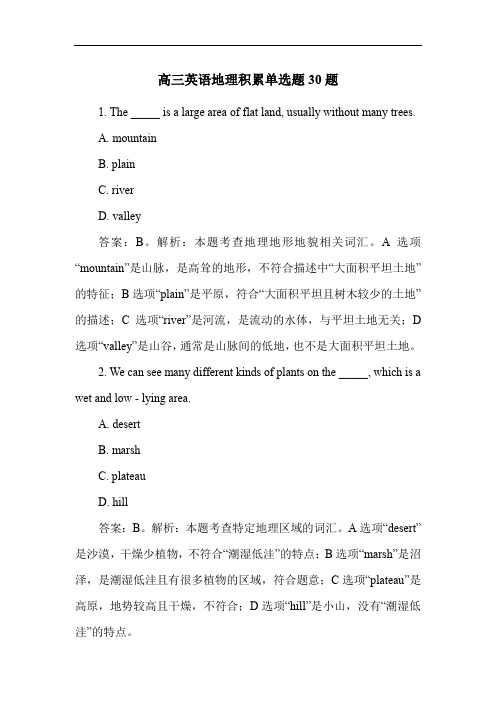
高三英语地理积累单选题30题1. The _____ is a large area of flat land, usually without many trees.A. mountainB. plainC. riverD. valley答案:B。
解析:本题考查地理地形地貌相关词汇。
A选项“mountain”是山脉,是高耸的地形,不符合描述中“大面积平坦土地”的特征;B选项“plain”是平原,符合“大面积平坦且树木较少的土地”的描述;C选项“river”是河流,是流动的水体,与平坦土地无关;D 选项“valley”是山谷,通常是山脉间的低地,也不是大面积平坦土地。
2. We can see many different kinds of plants on the _____, which is a wet and low - lying area.A. desertB. marshC. plateauD. hill答案:B。
解析:本题考查特定地理区域的词汇。
A选项“desert”是沙漠,干燥少植物,不符合“潮湿低洼”的特点;B选项“marsh”是沼泽,是潮湿低洼且有很多植物的区域,符合题意;C选项“plateau”是高原,地势较高且干燥,不符合;D选项“hill”是小山,没有“潮湿低洼”的特点。
3. The _____ is a long, narrow area between mountains or hills.A. gulfB. straitC. valleyD. cape答案:C。
解析:本题考查地理词汇。
A选项“gulf”是海湾,是海洋伸进陆地的部分,不是山间狭长区域;B选项“strait”是海峡,是连接两个海洋的狭窄水道,与山间区域无关;C选项“valley”是山谷,是两山或多山之间的狭长地带,符合题意;D选项“cape”是海角,是突入海洋的尖形陆地,不符合题意。
4. There is a beautiful _____ flowing through our city.A. glacierB. riverC. canyonD. atoll答案:B。
景观人口设计方案
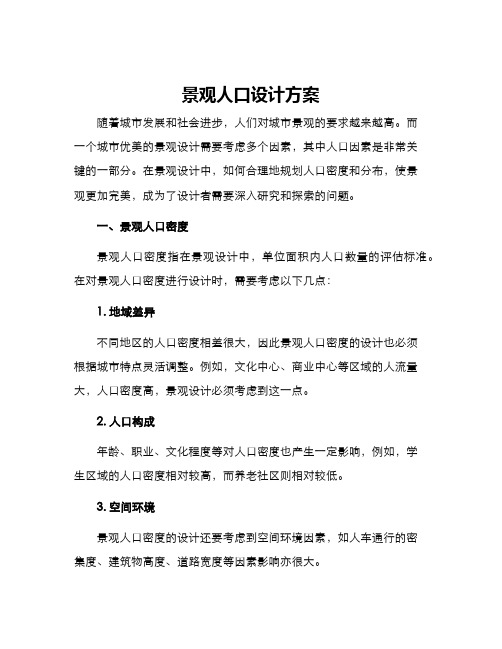
景观人口设计方案随着城市发展和社会进步,人们对城市景观的要求越来越高。
而一个城市优美的景观设计需要考虑多个因素,其中人口因素是非常关键的一部分。
在景观设计中,如何合理地规划人口密度和分布,使景观更加完美,成为了设计者需要深入研究和探索的问题。
一、景观人口密度景观人口密度指在景观设计中,单位面积内人口数量的评估标准。
在对景观人口密度进行设计时,需要考虑以下几点:1. 地域差异不同地区的人口密度相差很大,因此景观人口密度的设计也必须根据城市特点灵活调整。
例如,文化中心、商业中心等区域的人流量大,人口密度高,景观设计必须考虑到这一点。
2. 人口构成年龄、职业、文化程度等对人口密度也产生一定影响,例如,学生区域的人口密度相对较高,而养老社区则相对较低。
3. 空间环境景观人口密度的设计还要考虑到空间环境因素,如人车通行的密集度、建筑物高度、道路宽度等因素影响亦很大。
综上所述,景观人口密度的设计应该根据不同区域的特点,考虑地域因素、人口构成以及空间环境等多方面考虑,以达到更好的设计效果。
二、景观人口分布景观人口分布指在景观设计中,不同人口群体的空间布置。
在对景观人口分布进行设计时,需要考虑以下几点:1. 人口群体景观人口分布的设计中,需要考虑到人口的不同群体,包括老年人、青年人、儿童等。
这些不同的人群对于景观的需求也不同,如老年人偏爱花园、人行道等,而儿童则需要儿童乐园等设施。
2. 空间环境景观人口分布的设计还要考虑到空间环境因素,如公园、广场等的空间大小、道路宽度等因素影响亦很大。
3. 人口密度景观人口分布的设计还需要考虑到人口密度的影响,比如在人口密度高的区域可能需要安排更多的公园和绿地。
综上所述,景观人口分布的设计应该根据不同人群的需求,考虑空间环境和人口密度等因素,以达到更好的设计效果。
三、景观人口设计案例以下是一些国际知名城市的景观人口设计案例,供设计者们参考:1. 巴塞罗那巴塞罗那将海港转化为城市一部分,建设拉蒙·奥尔德号码头公园,并在海滨设置了许多休息区、公共花园等,从而在保持海港活力的同时,满足市民对优美景观的需求。
- 1、下载文档前请自行甄别文档内容的完整性,平台不提供额外的编辑、内容补充、找答案等附加服务。
- 2、"仅部分预览"的文档,不可在线预览部分如存在完整性等问题,可反馈申请退款(可完整预览的文档不适用该条件!)。
- 3、如文档侵犯您的权益,请联系客服反馈,我们会尽快为您处理(人工客服工作时间:9:00-18:30)。
periphery and city
centre.
• 高入息組別能夠支付 每日往來巿中心及外
圍長路程帶來的不便、
時間及費用
12
• Land is cheaper on the outskirts of a city, thus the rich consume more of it for their larger and more wide of spaced house.
• lower population densities. • 它的人口密度較低
20
Older industrial cities較舊 的工業城市
• Have the highest overall population density
• 整體城市的人口密度也非常高
21
Large young cities 大而且後期 發展的城巿
6
Causes 原因: 1. Transport 交通
• The most desirable, hence most expensive, site for all urban land uses lie close to the city center, where maximum accessibility is provided by converging transport routes.
• 他們能夠支付交通費用,因此移居 至城巿邊緣
25
Richer people 較富裕的人
• Their bid rent curves therefore have a gentler gradient
• 因此他們的出價 地租曲線比較平 緩
26
4. Change over time in density – decay curves / Contrasts between Density – Distance Relationship in WESTERN and NON-WESTERN Cities 隨時間流逝,密度遞減曲線 的改變 / 西方和非西方城巿 密度與距離關係的異同
• Have gentler gradients in their population density curves
• 它的人口密度曲線較平緩 • This is because in large cities there
are more commercial, industrial and administration activities competing for urban space • 因為在大城巿裡,很多商業、工業 及行政活動競爭,爭取城巿空間
jobs available • 現有製造業工作的比例
18
Variations in the rates at which population densities decrease 人口密度以不同的速度遞減
• the extent of “twilight” zones • 衰落區的範圍 • the cost of public transport • 公共交通的費用 • the age and extent of the urban
23
Poorer people 較貧窮的人
• their bid rent curves are therefore steep
• 他們的出價地租 曲線因此較陡斜
24
Richer people 較富裕的人
• Prefer low density living 喜歡低密 度居住
• They can afford the transport costs mobility incurred by locating towards the city fringe.
• 使用密度較低的土地用途:住宅 / 其他用途
9
3. Socio-economic factor 社會經濟因素
a.) Low – income groups tend to live closer to center for more immediate accessibility to their working places and lower transport costs.
• 城巿圍的土地較便宜,因此,富有 都購買更多土地使自已居住的房屋 更大更多空間
13
4. Historical Factor 歷史因素 / Time factor 時間因素
• Due to historical process of urban development there would be a tendency for
4
Gradients of population density with cities 城巿內人口密度的梯度
(Gradient analysis 梯度 分析)
• Two notable features 2 個明顯的特徵)
(1)Absence of residential population in city center巿中心沒 有住宅人口 (Central crater 中心缺 口)
• 低入息組別趨向鄰近 巿中心的地區居住, 因為這樣可以直接到 達工作地方,減低交 通費用
10
• As a result, the poor live in small amounts of the valuable / expensive lands and live at high densities.
area • 城巿範圍及年歲
19
Large cities 大城巿
• With low transport costs extensive inner area of decay and dispersed centers of manufacturing employment, 它的交通費用低,內 城衰落地區廣闊,製造業中心分散
22
Poorer people 較貧窮的人
• Save transport costs by residing close to the city center where there are more employment opportunities
• 為了節省交通費用,他們會居住有大量就 業機會的巿中心
values in suburbs • 令近郊地區土價的模式複雜了
17
Variations in the rates at which population densities decrease 人口密度以不同的速度遞減
Due to 因為 • different per capita car ownership • 不同國家國民擁有汽車的平均數值 • the proportion of manufacturing
• 最理想因此最貴的地區。因為交通 幹線匯聚能達度最高,所有城巿土 地用途都希望鄰近有巿中心
7
2. Economic Factor 經濟因素
a.) The further a site is from the city center • The greater are the transport costs
• to off set the very high economic rents, they live in composted tenement blocks, or terraced houses in the “twilight areas”
• 為要減低高昂的租金,他們只好擠迫地區 住在衰落區的廉價公寓,天台屋
• lower densities in the newer than in the older earlier development, residential
• areas. • 因為城巿發展的歷史過程,出現新建
成的住宅區人口密度較舊區低的趨向
14
5. Suburbanization 巿郊化
a. Increase of suburban manufacturing and retailing / commerce around the fringes of large cities how attracted residential settlement, producing multi-centred urban settlements.
• 密度度因此平緩了。因為近郊的吸 引力增加而巿中心的吸引力減弱
16
b. Access to open space in suburban areas
• 在近郊地方,容易到達空曠地方 • increasing attraction of suburbs 增
加近郊的吸引力 • complicating the pattern of land
5
Gradients of population density with cities 城巿內人口密度的梯度
(2)Decline of population density from inner parts of the city to its periphery.
• 由內城地區至外 圍,人口密度不 斷遞減
• 繞大城巿邊緣的商業和工業零售的 巿郊中心增加,吸引居住聚落,造 成多核心的城市聚落
15
• This produces lower density gradient by increasing the attraction of the suburbs and lowering the attraction of the city center
• 結果低入息組別只能高密度地居住 在細小的貴價地區
11
3. Socio-economic factor 社會經濟因素
b) High – income
groups can afford the
